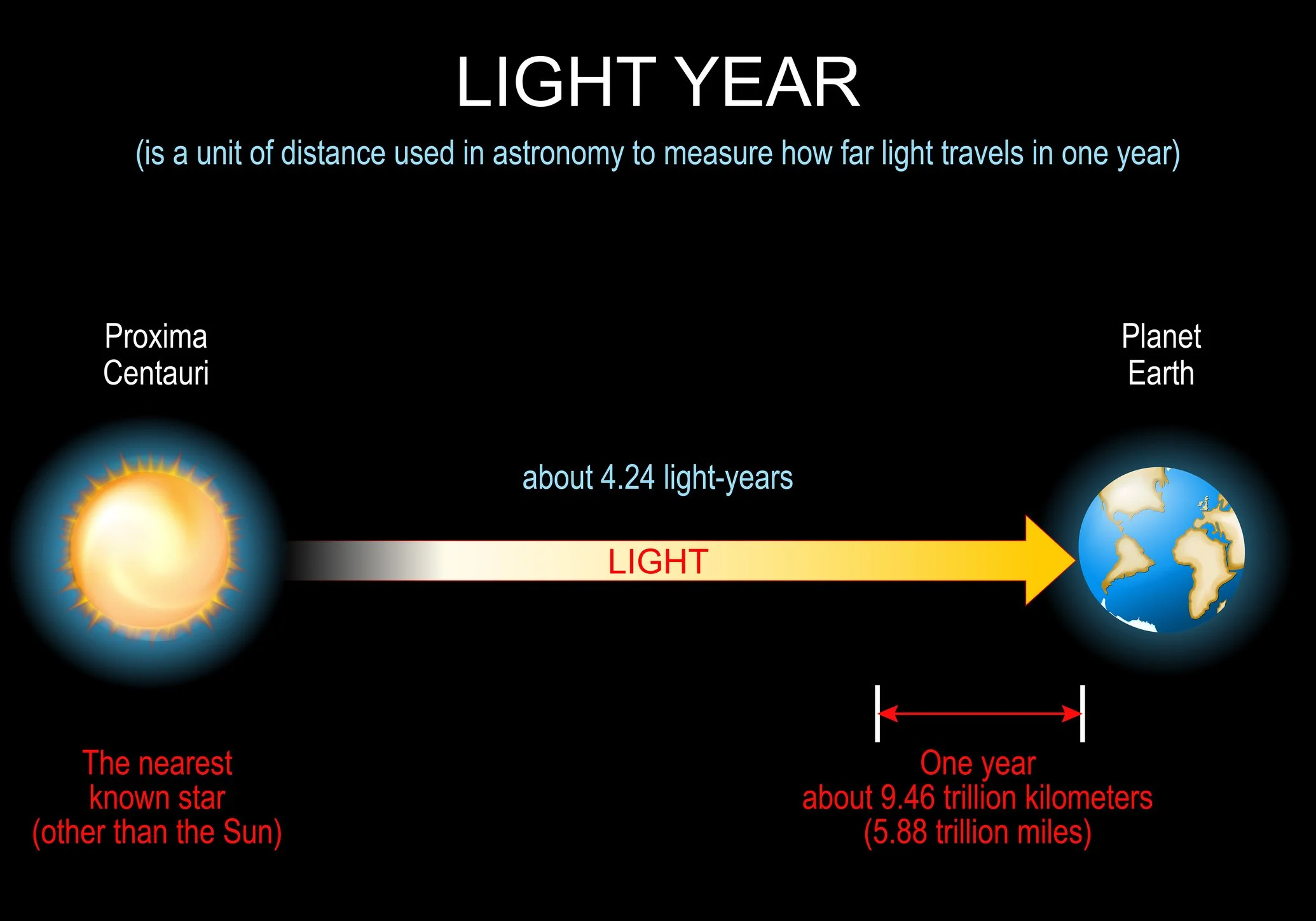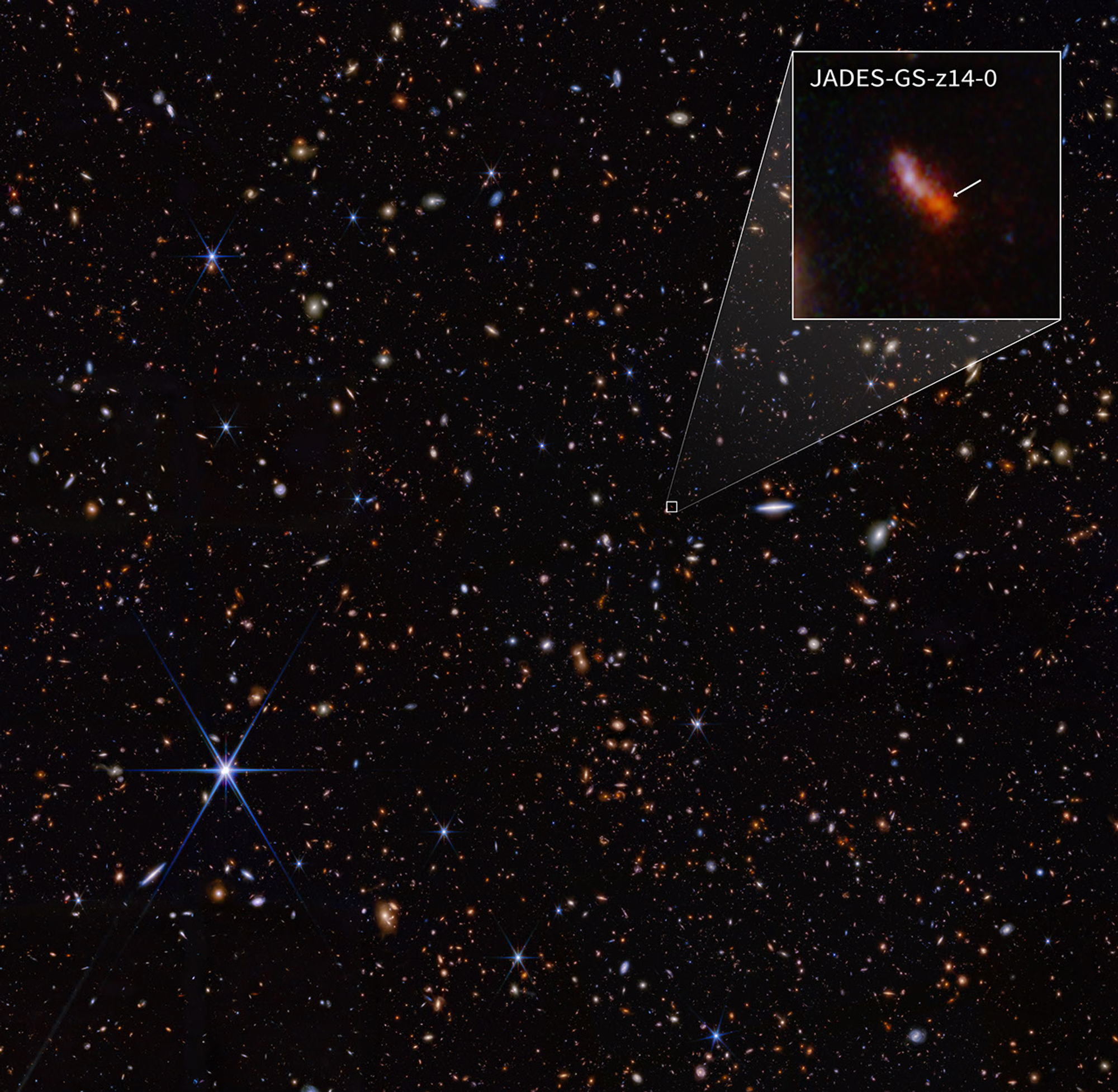Of Cosmic Time Scales and the Limits of Human Imagination
I have come to you today with another gem from NASA’s James Webb Space Telescope (JWST)–the most distant galaxy ever observed, located at a distance of 13.4 billion light years. In contrast, the star nearest to us (other than our sun), Proxima Centauri, is just 4.25 light-years away. That sounds quite close. Wait, do I really understand how far away one light-year is? Actually, what is a light-year?
In simple words, one light-year is the distance traveled by light in one year [1]. Now consider this: the speed of light is approximately 300,000 km/sec (or 186,000 miles/sec). So, one light-year is equal to a distance of 300k km × 60 sec × 60 min × 24 hours × 365 days, which is a whooping 9.4 trillion (1012) km (or 5.8 trillion miles). Coming back to the cosmic characters in the previous paragraph, the star Proxima Centauri is only 4.25 light-years away (Fig 1). In other words, it is only 40.2 trillion km away. Close enough for a weekend getaway, if you could find a way to travel many times faster than the fastest ‘physical’ thing in the Universe–light [2]!
Fig 1: Our nearest stellar neighbor, Proxima centauri, is only 4.25 light-years away from us. (Image credit: iStock)
Now, let us move to the other end of the spectrum–the most distant galaxy ever observed. The JADES-GS-z14-0 galaxy held this record till a few months back, although it has recently been upstaged by the galaxy MoM-z14 (Fig 2). JADES-GS-z14-0 is located at a distance of 13.4 billion light-years. This essentially means that the light from this distant galaxy has travelled at a speed of 300k km/sec for 13.4 billion years, covering a total distance of 126 sextillion (1021) km (or 77.7 sextillion miles) before striking the mirror of JWST. Now comes the interesting part. The Universe has expanded a lot in the 13.4 billion years that it took for the light from this galaxy to reach us. Hence, the galaxy JADES-GS-z14-0 is even further away from us now than it was when the light rays currently reaching us left the galaxy. In fact, it is currently estimated to be 33.8 billion light-years (312 sextillion km) away from us.
Fig 2: JADES-GS-z14-0: The most distant galaxy ever observed by the James Webb Space Telescope. (Image credit: STScI/JWST)
Those are some mind-boggling numbers! In fact, I cannot really comprehend how different 126 sextillion km is from 312 sextillion km, or from 40 trillion km. I haven’t even travelled a million kilometers on our planet in my lifetime. For earthlings like me, trying to measure cosmic distances in kilometers would be like using a wooden ruler to measure the distance between USA and Europe. The solution is to find a bigger ruler, one fit for its purpose. When it comes to deep space, that ruler is a light-year. It can even be shredded further into light-minutes or light-seconds to calculate distances from our neighbors in the solar system. The moon is incredibly close, because it is just 1.3 light-seconds away (384k km or 240k miles) [3]. The sun is further away at 8.3 light-minutes (149 million km or 93 million miles), while Mars and Jupiter are nearly 13 and 40 light-minutes away from us, although this varies widely, depending on their orbital positions [4]. Let us venture out of our solar system with the tool of ‘light-year’ in our hands. As mentioned before, Proxima Centauri is our stellar neighbor at just 4 light-years away (I laughed when I typed ‘just’ before ‘4 light-years’; the concept of light-years has suddenly made astronomical distances seem diminutive 😊). The Proxima Centauri is a part of a triple star system. You will be unable to spot this star in the night sky, because it is a dim red dwarf star. However, if you live in the Southern Hemisphere, or the southern parts of the Northern Hemisphere, you can spot the other two stars, Alpha Centauri A & B (Fig 3) [5]. In the night sky, these stars are located near to the Crux, the most prominent constellation of the Southern Hemisphere. Also known as the Southern Cross, it consists of four bright stars located close to each other at a distance of 88-360 light-years away from Earth [6].
Fig 3: Two stars of the Alpha Centauri system alongside the Crux constellation in the night sky. (Image credit: iStock)
Stargazers living in the Northern Hemisphere can spot Sirius A, or the dog star, which is the brightest star in Earth’s night sky and is just 8.6 light years away [7]. Not many know that this bright star has a stellar companion, Sirius B, which is a white, dwarf star. The latter is tiny and has a diameter of only 12,000 km (phew, finally, a distance that my tiny brain can comprehend). It is actually a remnant of a star similar in size to our sun. Sirius B cannot be spotted with the naked eye, but Sirius A is easily seen as the brightest star in the night sky, located in line with the three stars of Orion’s belt (Fig 4).
Fig 4: Sirius is situated on an imaginary line drawn through the three stars on Orion’s belt. (Image credit: iStock)
The adjacent placement of Sirius and Orion constellation in our night sky is an illusion, though. While Sirius is less than a light-decade away from Earth, Orion is situated much further away at a distance of 243-1360 light-years [8]. By now, I am starting to accept that astronomical distances stretch way beyond the limits of my imagination. Thankfully, the beautiful places of this world are not beyond my imagination or reach. The river bank is just a 100-meters away; after a session of JWST therapy, I head there to lounge under the night sky and be washed over by starlight which started its journey long before I opened my eyes or took my first steps in this wonderful world.
References:
[1] https://science.nasa.gov/exoplanets/what-is-a-light-year/
[2] https://www.skyatnightmagazine.com/space-science/fastest-things-in-universe
[3] https://www.grc.nasa.gov/www/k-12/Numbers/Math/Mathematical_Thinking/seeing_the_earth_moon.htm
[4] https://lovethenightsky.com/how-far-away-is-mars/
[5] https://svs.gsfc.nasa.gov/20377
[6] https://earthsky.org/constellations/crux-the-southern-cross-jewel-box/




